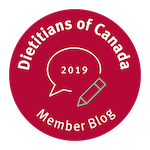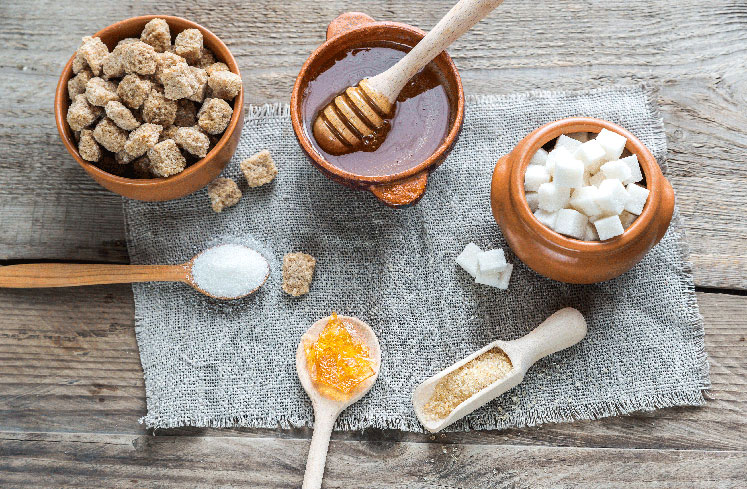Sugar is in the spotlight and people are wondering, “How much is too much?” Read on to find out how you can make sense of the sugar we eat.
Is honey better than white sugar? Should we be limiting the amount of sugar we get from fruit? With all of the misinformation piling up on the internet, it can be hard to know where to turn for answers to all of our sugar questions. Learn all you need to know about sugar below.
What is sugar?
Sugar is a type of carbohydrate found in many foods. There are different kinds of sugar that can be in foods:
- Naturally occurring sugars are the sugars found in foods such as fruit, vegetables and unsweetened dairy products. All of these foods naturally contain sugars in the form of fructose, glucose, and lactose.1
- Added sugars are the sugars that are added to food and beverages by the manufacturer, cook or consumer.1 e.g. adding brown sugar or corn syrup while baking. All added sugars are also free sugars.
- Free sugars refer to added sugars as well as sugars naturally present in honey, syrups, fruit juices, and fruit juice concentrates. e.g. maple syrup, agave nectar and 100% fruit juice.1,2 The sugar naturally present in fruit, vegetables or unsweetened dairy products are not counted as free sugar.
- Total sugars include all sugars from food and beverages that are naturally occurring, added and free sugars.1
Regardless of the source of sugar, your body digests all sugars into glucose to be used for energy.
Do I need to avoid foods with naturally occurring sugar?
No, there is no reported evidence of adverse effects from consuming foods with naturally occurring sugars, like vegetables, fruit and dairy products.2 These foods are nutritious and are part of a healthy pattern of eating. Vegetables, fruit, and dairy products provide us with many beneficial nutrients including fiber, calcium, vitamin D, vitamin C, vitamin A, phosphorus, protein, and potassium. In fact, most Canadians don’t get enough of these foods.3
Should I limit the amount of free sugars I have?
Yes. Canada’s food guide recommends reducing free sugars intake to less than 10% of total energy intake.1 For example, if an individual consumes 2000 calories a day, they should try to limit their free sugars intake to less than 50 g or 12 tsp each day. This recommendation to limit free sugars includes reducing white sugar and high fructose corn syrup as well as molasses, honey, raw sugar, maple syrup, fruit juice concentrate, etc. They are all sugar.
“To help reduce the intake of free sugars, the majority of total sugars intake should come from nutritious foods, such as intact or cut fruit and vegetables, and unsweetened milk.”8
-Health Canada
How well are Canadians doing?
A recent report from Statistics Canada focused on the long-term trend in total sugars consumption among Canadian children and adults. The report found that overall, total sugars consumption—which includes free and naturally occurring sugars—decreased for all age groups from 2004 to 2015.
The decrease in total sugars intake reflects a decline in the consumption of sugary beverages since 2004. With this being said, sugary drinks are still the main source of total sugars in the diets of Canadians, accounting for 22% of total sugars for younger children, 30% for older children, and 24% for adults.4
This report shows promising data that Canadians are making an effort to reduce their total sugar intake — especially through reducing sugary beverage intake.
Why is too much added sugar a problem?
Consuming too much added and free sugars can be a problem when it starts to displace foods that contain important nutrition. This imbalance can lead to negative health outcomes. The consumption of sugary beverages is associated with a higher risk of dental decay and poor oral health in children.5 Furthermore, excessive consumption of foods and beverages with free sugars has been associated with an increased risk of weight gain, obesity6,7 and type 2 diabetes.8
So how can I reduce my sugar intake?
Sugar adds flavour to food and is one of the great pleasures in life, so we don’t want to demonize it. But, we can be mindful of where it’s coming from and most often choose naturally occurring sources of sugar that promote health and satisfaction.
Health Canada recommends, “To help reduce the intake of free sugars, the majority of total sugars intake should come from nutritious foods, such as intact or cut fruit and vegetables, and unsweetened milk.”8
Below are tips to maximize taste and nutrition while minimizing sugar
| For breakfast: Try muesli or plain oatmeal with fruit, nuts, milk/yogurt and a dash of cinnamon. |
For drinks: Health Canada recommends drink choices such as:
|
For snacks: Opt for delicious and wholesome food between meals, such as:
|
| For dessert: Satisfy a sweet tooth with fresh baking at home! The sugar in most baked goods recipes can be cut down by one-third. Or, you can check out Bake Better Bites for baking ideas that are lower in sugar! |
| Spice it up anytime: Swap sugar with cinnamon in cereal, vanilla in a latte, or squeeze lemon or lime on fruit and vegetables. |
Bottom Line
Sugar can be added to food for many reasons, including to improve the taste and enjoyment of food. It is important that you like what you eat so choose the sweetener you enjoy the most. If that’s organic honey, that’s fine. If that’s white table sugar, that’s okay too. But no matter what you choose, use it in small amounts. Focus on including the foods that contain naturally-occurring sugars and plenty of nutrients, such as fruits, vegetables, and unsweetened dairy products on a regular basis.
Article updated April 2019 by Carmen Gorlick, RD.

References
- Health Canada. (2019). Foods and beverages that undermine healthy eating. Retrieved from: https://food-guide.canada.ca/en/guidelines/section-2-foods-and-beverages-that-undermine-healthy-eating/
- World Health Organization. (2015). WHO calls on countries to reduce sugars intake among adults and children. Retrieved from: https://www.who.int/mediacentre/news/releases/2015/sugar-guideline/en/
- Tugault-Lafleur CN, Black JL. Differences in the quantity and types of foods and beverages consumed by Canadians between 2004 and 2015. Nutrients. 2019;11(3):526.
- Statistics Canada. (2019). Change in total sugars consumption among Canadian children and adults. Retrieved from: https://www150.statcan.gc.ca/n1/pub/82-003-x/2019001/article/00002-eng.htm
- Moynihan PJ, Kelly SA. Effect on caries of restricting sugars intake: systematic review to inform WHO guidelines. Journal of Dental Research 2014; 93(1):8-18.
- Te Morenga L, Mallard S, Mann J. Dietary sugars and body weight: systematic review and meta-analyses of randomised controlled trials and cohort studies. BMJ 2013; 346: e7492.
- Malik VS, Pan A, Willett WC, Hu FB. Sugar-sweetened beverages and weight gain in children and adults: a systematic review and meta-analysis. The American Journal of Clinical Nutrition 2013; 98(4): 1084-1102.
- Health Canada. (2019). Sugars: Health effects and recommendations. Retrieved from: https://www.canada.ca/en/health-canada/services/nutrients/sugars.html#he.
